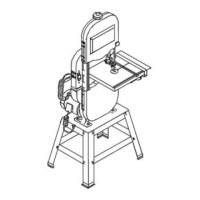When cutting curves, carefully turn the workpiece so the
blade follows without twisting, If the curve is so sharp
that you repeatedly back up and cut new kerf, use a
narrower blade, or a blade with more set (teeth further
When a blade has more set, the workpiece turns
easier but the cut is rougher.
When changing a cut, do not withdraw the workpiece
from the blade. The blade may get drawn off the wheels.
To change a cut, turn the workpiece and saw out
through the scrap material area.
When cutting long curves, make relief cuts as you go
1. Adjust the guide assembly to 1/8” (3.18mm) above
2. Use both hands while feeding the work into the
blade.Hold the workpiece fi rmly against the table.
Use gentle pressure. Do not force the work, ALLOW
3. The smallest diameter circle that can be cut is
determined by the width of the blade. For example,
a 1/4” (6.35mm) wide blade will cut a minimum
approximately 1-1/2” (38.1mm).
blade teeth are sharp. Use care when
For longest wear and best cutting results, use the
correct blade thickness width, and temper for the type of
When sawing small curves and delicate work, use
blades. Otherwise, use the widest blade
cutting wood and similar materials
purchase blades in widths up to 1/2”
Do not cut ferrous metals with this band saw.
Common causes of blade breakage:
• Poor guide alignment and adjustment.
• Forcing or twisting a wide blade around a short
• Dull teeth or not enough set.
• Too much blade tension.
For longest wear and best cutting results, use the
correct blade thickness width, and temper for the type of
When sawing small curves and delicate work, use
narrow blades. Otherwise, use the widest blade
possible, For cutting wood and similar materials with
this bandsaw, purchase blades in widths up to 1/2 ”
(12.7mm) , and a length of 80’’ (203.2cm).
Do not cut ferrous metals with this band saw.
Common causes of blade breakage:
• Poor guide alignment and adjustment.
• Forcing or twisting a wide blade around a short
• Dull teeth or not enough set.
• Too much blade tension.
• Setting top guide assembly too high above the
• Lumpy or improperly fi nished braze or weld on the
• Continuous running of blade when not cutting.
BLADE SPEED SELECTION (FIG. W)
This band saw has two speed settings:
1. 11.7 m/s for normal operation.
2. 6 m/s for operation requiring more control.
Recommended Blade Width (mm)
1. Intricate wood cutting
3. Nonterrous metals; brass.

